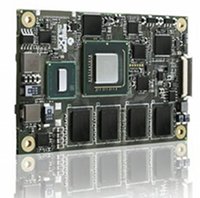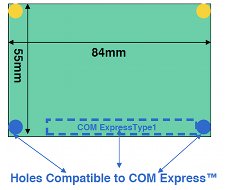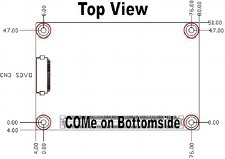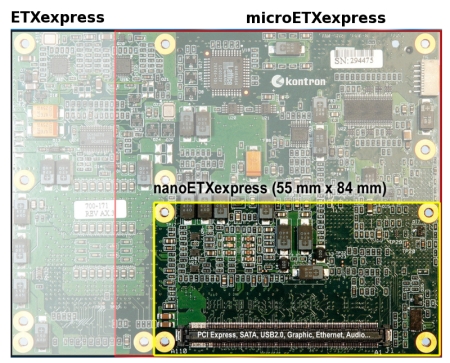Credit-card-size COM gets dual displays, more memory
Dec 18, 2009 — by LinuxDevices Staff — from the LinuxDevices Archive — 3 viewsKontron announced an updated design for a credit-card-size COM (computer on module) using the company's nanoETXexpress form factor. The nanoETXexpress-SP now supports up to 2GB of RAM and 8GB of onboard flash storage, and offers both LVDS and SDVO display outputs, the company says.
When it made its debut in April 2008, Kontron's original nanoETXexpress-SP was one of the very first Intel Atom-powered devices, sporting either the 1.1GHz Z510 or 1.6GHz Z530. The module employed the 3.3 x 2.2-inch form factor that was originally introduced by Kontron as nanoETXexpress, and was subsequently submitted to the PICMG (PCI Industrial Computer Manufacturers Group) under the proposed neutral name, COM Express Ultra (see later in this story for background).
Kontron's revised nanoETXexpress-SP retains the same form factor as before, but is now available with an optional SDVO connector, according to the company. Since LVDS signaling was already offered via the module's Type I COM Express pinout, the device now supports dual displays, enabling a number of innovative mobile applications, according to Kontron.


Kontron's nanoETXexpress-SP in its new (left) and old (right) versions
In another engineering change, the new module (above left) has been redesigned to support eight memory chips instead of the four on the previous version (above right). As a result, the maximum amount of available RAM — still soldered-on — has doubled to 2GB, and so has available flash storage (up to 8GB).
As before, the nanoETXexpress-SP uses the 1.1GHz Atom Z510 or 1.6GHz Atom Z530, with 400MHz or 533MHz frontside busses, respectively. Meanwhile, the SCH US15W (system controller hub) companion chip once again integrates northbridge and southbridge funtionality, giving the COM OpenGL 3D graphics, support for DirectX 9, plus hardware-accelerated 720p and 1080i video decoding, according to Kontron.
The nanoETXexpress-SP also includes a SATA port, eight USB ports, gigabit Ethernet, high-definition audio, and an SDIO port. Expansion potential is provided by a one-lane PCI Express interface, Kontron adds.
Features and specifications listed by Kontron for the revised nanoETXexpress-SP include:
- Processor — Intel Atom Z510 (1.1GHz) or Z530 (1.6GHz)
- Chipset — SCH US15W
- Memory — 512MB to 2GB of soldered-on RAM
- Storage — 512MB to 8GB of flash
- Display — single-channel LVDS interface with resolutions up to 1366 x 768; optional SDVO interface with resolutions up to 1920 x 1080
- Expansion:
- SDIO port
- 1 x 1-lane PCI Express (2 x 1-lane PCI Express if Ethernet is not used)
- Networking — 10/100/1000 Ethernet
- Other I/O:
- 8 x USB
- SATA
- Operating range — 32 to 140 deg. F (0 to 60 deg. C)
- Power requirements and consumption — 12VDC, 4.5 Watts typical consumption
- Dimensions — 3.3 x 2.2 inches
- Operating system — Linux, Windows XP SP3, Windows XP Embedded, Windows CE, VxWorks, QNX
Background
Last March, Aaeon, Adlink, Advantech, and Kontron jointly released revision 1.0 of the nanoETXexpress specification, and presented it to the PICMG (PCI Industrial Computer Manufacturers Group) under the proposed neutral name, COM Express Ultra. The 1.0 spec adds SDVO signal transport via a separate flat-foil connector, which can be used alongside the LVDS output already provided by the COM Express connector, according to the companies.


COM Express Ultra (left), aka nanoETXexpress, allows for an add-on SDVO connector (right)
(Click either to enlarge)
COM Express Ultra uses a Type I COM Express pinout, sending almost all its signals over a single 220-pin connector (above left). Optionally, 30-pin Hirose FH12-compatible connector can be located on the side of a module (above right), providing access to SDVO signals.
The original nanoETXexpress design derives from 2003's ETXexpress, created by Kontron and later adopted as the PICMG COM Express standard. In 2006, Kontron introduced the cut-down version of COM Express known as microETXexpress, and nanoETXexpress followed in July 2007.

Comparison of COM form-factors
(Click to enlarge)
All three COMs share the same baseboard interface connector design and pinout, and have overlapping mechanical assemblies, as illustrated above. Footprints vary, as follows:
- COM Express (formerly ETXexpress):
- basic form-factor — 125 x 95mm (4.9 x 3.7 inches)
- extended form-factor — 155 x 110mm (6.1 x 4.33 inches)
- microETXexpress (now proposed as COM Express Compact) — 95 x 95mm (3.7 x 3.7 inches)
- nanoETXexpress (now proposed as COM Express Ultra) — 84 x 55mm (3.3 x 2.16 inches)
Availability
Kontron did not release pricing for the revised nanoETXexpress-SP, but the device appears to be available now. More information may be found on the company's website, here.
Revision 1.0 of the nanoETXexpress specification, proposed as COM Express Ultra, can be downloaded here.
This article was originally published on LinuxDevices.com and has been donated to the open source community by QuinStreet Inc. Please visit LinuxToday.com for up-to-date news and articles about Linux and open source.